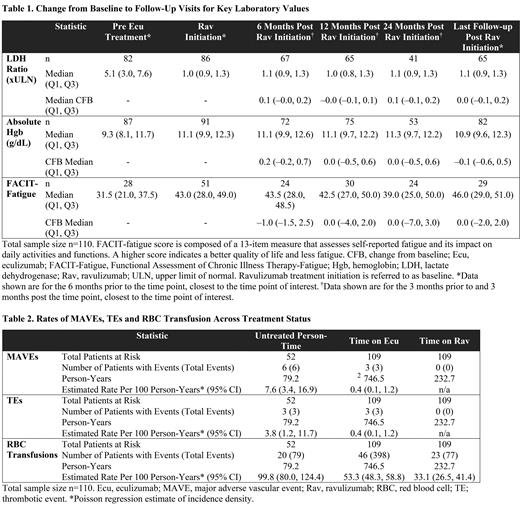Background
Paroxysmal nocturnal hemoglobinuria (PNH) is a rare disease of uncontrolled terminal complement activation on blood cells that can cause intravascular hemolysis (IVH), major adverse vascular events (MAVEs), including thromboembolic events (TEs), and organ damage resulting in early mortality. Complement C5 inhibitors eculizumab (Ecu) and ravulizumab (Rav) are standard-of-care treatments that inhibit terminal complement activity and reduce morbidity and mortality by controlling IVH (reduction of lactate dehydrogenase [LDH]) and preventing TEs. Rav provides the same benefits as Ecu but with substantially longer half-life, improved control of terminal complement, and reduction in breakthrough intravascular hemolysis achieved via weight-based dosing, thus reducing the burden of treatment. Long-term efficacy and safety data are available for up to 20 y from trials and real-world evidence (RWE) with Ecu and up to 6 y from trials in patients (pts) treated with Rav who were naïve to C5 inhibitors or who switched from Ecu to Rav; however, RWE is limited with Rav. The objective of this analysis was to describe pt characteristics at treatment initiation, outcomes, and changes from treatment initiation in laboratory markers of pts switching to Rav from Ecu using data from the prospective, observational International PNH Registry (NCT01374360).
Methods
The PNH Registry is the largest global real-world database of pts with PNH and provides extensive information on the natural history of PNH, irrespective of PNH treatment status. This analysis included data from pts enrolled in the PNH Registry, with complete information for birth date, sex, enrollment date, and Ecu/Rav treatment status. Pts included in the study switched from >6 mos of Ecu treatment to Rav for >6 mos. Pts were required to have discontinued Ecu within <28 days of Rav initiation. Changes from Rav treatment initiation (baseline) in key laboratory values, including LDH ratio, absolute hemoglobin (Hgb) levels, and Functional Assessment of Chronic Illness Therapy-Fatigue (FACIT-Fatigue) scores were analyzed descriptively. Poisson regression estimate of incidence density was used for MAVEs, TEs, and red blood cell (RBC) transfusion rates across treatment exposure during registry follow-up. High disease activity (HDA), defined as LDH ≥1.5 X upper limit of normal and ≥1 of the following: history of a MAVE (including TE), anemia (Hgb <10 g/dL), or physician-reported abdominal pain, dyspnea, dysphagia, fatigue, hemoglobinuria and/or erectile dysfunction, was assessed during follow-up visits.
Results
As of 3 April 2023, 110 pts in the International PNH Registry had switched to Rav for ≥6 mos. The median age at start of Rav treatment was 42.1 y (Q1, Q3: 33.1, 52.2 years), 50% were female, and 70% were non-Asian. Over 24 mos of follow-up time was recorded for >50% of pts from the analysis population. The median time on Ecu was 6.5 y and Rav was 2 y. During Ecu treatment and before Rav initiation, 20/42 (47.6%) pts had ongoing bone marrow disorder (eg, aplastic/hypoplastic anemia, myelodysplastic syndromes). Before Ecu treatment, 24/101 (23.8%) pts had MAVEs (TE, 18/100 [18.0%] pts) and at Rav initiation, 27/109 (24.8%) pts had MAVEs (TE, 21/109 [19.3%] pts). Over time, Rav maintained IVH and disease control, with minimal change across time points for LDH ratios, absolute Hgb levels, and FACIT-Fatigue scores ( Table 1). Rates of clinical events (ie, MAVEs, TEs, and RBC transfusions) decreased over time from untreated time to time on Ecu treatment and were lowest when pts were treated with Rav ( Table 2). There were no reported MAVEs and TEs in pts treated with Rav. At Rav initiation, 6/65 pts still had HDA; only 1/6 had HDA at last follow-up visit while on Rav. No meningococcal infections or deaths were reported during Rav treatment. Four pts had discontinued Rav treatment (physician decision, switched to other anti-complement treatment, lack of efficacy).
Conclusions
These data from the International PNH Registry, one of the largest global real-world datasets of Rav-treated pts, confirmed that improvements in clinical outcomes observed with Ecu, including control of IVH, Hgb level, RBC transfusion rates, and fatigue, were maintained with Rav. HDA resolved in most pts when switching from Ecu to Rav. Transfusion rates were lowest with Rav treatment. Pts treated with Rav experienced no MAVEs, TE, meningococcal infections, or deaths.
Disclosures
Roeth:Apellis Apellis Pharmaceuticals: Consultancy, Honoraria; Bioverativ: Consultancy, Honoraria; Novartis: Consultancy, Honoraria; Roche: Consultancy, Honoraria, Research Funding; Sanofi: Consultancy, Honoraria; Alexion, AstraZeneca Rare Disease: Consultancy, Honoraria; Biocryst: Consultancy, Honoraria. Patriquin:Regeneron: Other: clinical site investigator; Alexion, AstraZeneca Rare Disease: Consultancy, Honoraria, Other: clinical site investigator, Speakers Bureau; Apellis: Consultancy, Honoraria, Other: clinical site investigator, Speakers Bureau; BioCryst: Consultancy, Honoraria, Speakers Bureau; Takeda: Consultancy, Honoraria, Speakers Bureau; Novartis: Consultancy, Honoraria, Speakers Bureau. Szer:Sanofi: Consultancy, Honoraria, Membership on an entity's Board of Directors or advisory committees, Speakers Bureau; Alexion, AstraZeneca Rare Disease: Honoraria, Membership on an entity's Board of Directors or advisory committees, Speakers Bureau; Prevail Therapeutics: Honoraria, Membership on an entity's Board of Directors or advisory committees, Speakers Bureau; Pfizer: Honoraria, Membership on an entity's Board of Directors or advisory committees, Speakers Bureau; Apellis: Honoraria, Membership on an entity's Board of Directors or advisory committees, Speakers Bureau; Novartis: Honoraria, Membership on an entity's Board of Directors or advisory committees, Speakers Bureau. Terriou:Alexion, AstraZeneca Rare Disease: Consultancy, Membership on an entity's Board of Directors or advisory committees. Patel:Alexion, AstraZeneca Rare Disease: Current Employment, Current equity holder in publicly-traded company. Gustovic:Alexion, AstraZeneca Rare Disease: Current Employment, Current equity holder in publicly-traded company. Nishimura:Roche: Membership on an entity's Board of Directors or advisory committees; Chugai Pharmaceutical Co., Ltd: Membership on an entity's Board of Directors or advisory committees; Alexion, AstraZeneca Rare Disease: Honoraria, Membership on an entity's Board of Directors or advisory committees, Research Funding. Brodsky:Alexion, AstraZeneca Rare Disease: Research Funding.


This feature is available to Subscribers Only
Sign In or Create an Account Close Modal